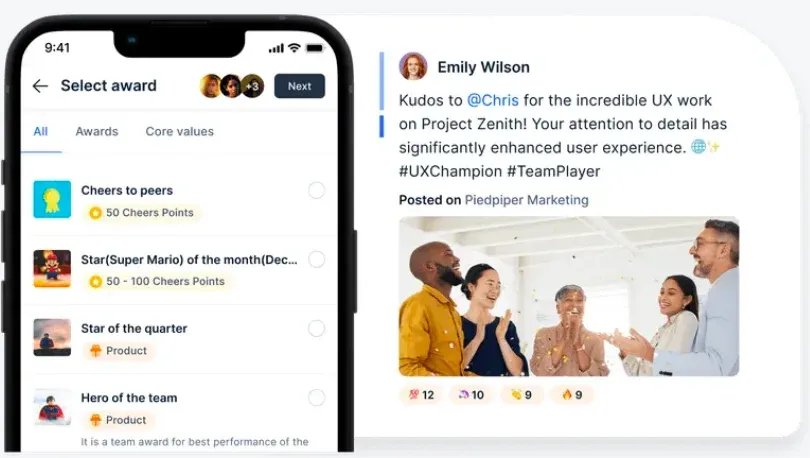Table of Contents
Southwest Airlines has a long history of valuing its employees, with leaders like Colleen Barrett writing thank-you notes to employees. In recent years, the company has instituted more formal recognition programs. One program is called Kick Tail and allows employees to recognize each other for good work. Another program is called SWAG and awards points to employees for good performance. These points can be redeemed for travel, merchandise, or gift cards.
Recognition has been shown to be a crucial factor in boosting employee engagement. According to a Deloitte article, organizations that implement employee recognition programs experience a 14% increase in employee engagement compared to those that do not.
Recognition plays a crucial role in building trust within organizations. A study by Work Human found that frequent recognition is one of the most effective ways for managers and senior leaders to build trust. Employees who received recognition were 34% more likely to trust senior leaders and 33% more likely to trust managers compared to those who had never been recognized.
Why employee recognition matters
Employee recognition programs are vital for fostering a positive work environment, enhancing employee engagement, and driving business success. According to a Gallup poll, only one in three workers in the U.S. strongly agree that they received recognition or praise for doing good work in the past seven days. This lack of recognition can lead to disengagement, which costs U.S. companies up to $550 billion annually.
The benefits of employee recognition
Increased productivity: Recognized employees are more motivated and productive. According to a study by O.C. Tanner, around 75% of associates receiving recognition, employees report a significant boost in motivation to contribute to the company's success.
Enhanced employee satisfaction: Regular recognition boosts employee satisfaction, reducing turnover rates. A Bersin & Associates study found that companies with effective recognition programs have 31% lower voluntary turnover.
Better Team Collaboration: Recognition fosters a sense of camaraderie and collaboration among team members. Employees are more likely to support each other when they feel valued.
Steps to design an effective employee recognition plan
1. Define your objectives
Before designing your recognition plan, it's crucial to identify what you want to achieve. Are you aiming to boost morale, increase productivity, or reduce turnover? Clear objectives will guide your program's structure and metrics.
2. Understand your workforce
Different employees are motivated by different types of recognition. Conduct surveys or focus groups to understand what types of recognition resonate most with your workforce. Some may prefer public acknowledgment, while others might appreciate private praise or tangible rewards.
3. Develop a recognition framework
A well-structured framework is essential for consistency and fairness. Your framework should include:
- Criteria for Recognition: Define clear criteria for what constitutes excellent performance or behavior.
- Types of Recognition: Decide on the forms of recognition you will offer, such as verbal praise, awards, bonuses, or extra time off.
- Frequency: Determine how often recognition will be given—daily, weekly, or monthly.
4. Implement a multi-tiered approach
A multi-tiered recognition approach ensures that all levels of contribution are acknowledged. Consider implementing:
Peer-to-Peer Recognition: Encourage employees to recognize each other's efforts.
Example- Google’s peer-to-peer bonus system
Google takes peer recognition to the next level with its program simply called "Peer Bonus." This innovative system empowers employees to directly acknowledge exceptional contributions from their colleagues. Through a shared platform, employees can express gratitude and highlight achievements with personalized messages and notes.
Manager-to-Employee Recognition: Managers should regularly acknowledge their team's achievements.
Company-Wide Recognition: Celebrate significant milestones and accomplishments at the organizational level.
5. Utilize technology
Leverage technology to streamline and scale your recognition efforts. Platforms like Empuls offer easy-to-use tools for peer recognition, tracking, and reporting.

6. Measure and iterate
Regularly assess the effectiveness of your recognition program. Use metrics such as employee engagement scores, turnover rates, and productivity levels to gauge success. Solicit feedback from employees to identify areas for improvement and iterate accordingly.
Case Study: Transforming Employee Recognition at Luminous Power Technologies with Empuls
Company: Luminous Power Technologies, India
Industry: Manufacturing (Lighting Solutions)
Challenge: Luminous Power Technologies, a large Indian company with over 6,000 employees, sought to standardize and improve its employee recognition program. Previously, recognition was inconsistent and relied heavily on physical certificates or printed materials distributed during in-person meetings or leadership visits. This meant geographically dispersed employees or those with less frequent leadership interaction were less likely to be recognized for their contributions.
Solution: Luminous implemented Empuls, a digital employee recognition and rewards platform. Empuls offered several key advantages:
Ease of use: The platform was user-friendly, allowing employees to quickly give and receive recognition online, regardless of location.
Integration: Empuls integrated seamlessly with existing company systems, streamlining adoption and usage.
Reward variety: Empuls offered a wide range of rewards catering to different generations of workers. This included digital badges, redeemable points for merchandise or experiences, and peer-to-peer recognition messages.
Remote recognition: Empuls eliminated geographical barriers, enabling recognition for remote employees and those with less frequent face-to-face interaction.
Results: The Empuls implementation yielded significant improvements in employee recognition at Luminous:
Increased Recognition: The user-friendly platform encouraged employees to recognize their peers more frequently.
Improved Engagement: Employees felt more valued and appreciated for their contributions, leading to increased engagement.
Standardized Recognition: Empuls established a consistent recognition process across all departments.
Remote Inclusion: Geographically dispersed employees and those with less frequent leadership interaction were now acknowledged for their work.
There are over 2500+ people leaders trust Empuls and the saw a 65% reduced HR and admin effort.
Key takeaways:
This case study by Luminous Power Technologies highlights the effectiveness of a digital employee recognition platform like Empuls. Here are key takeaways for organizations looking to improve their recognition programs:
- Digital platforms like Empuls offer ease of use, accessibility, and integration capabilities, fostering a more robust recognition culture.
- Provide a variety of rewards to cater to different employee preferences and generations.
- Ensure recognition reaches all employees, regardless of location, fostering inclusivity.
- Monitor program usage and employee feedback to continually improve the recognition experience.
Conclusion
Implementing a well-rounded and thoughtful employee recognition program can significantly enhance workplace culture, employee satisfaction, and overall business success. By recognizing and celebrating the efforts and achievements of your employees, you not only boost their morale but also foster a loyal and high-performing team.



